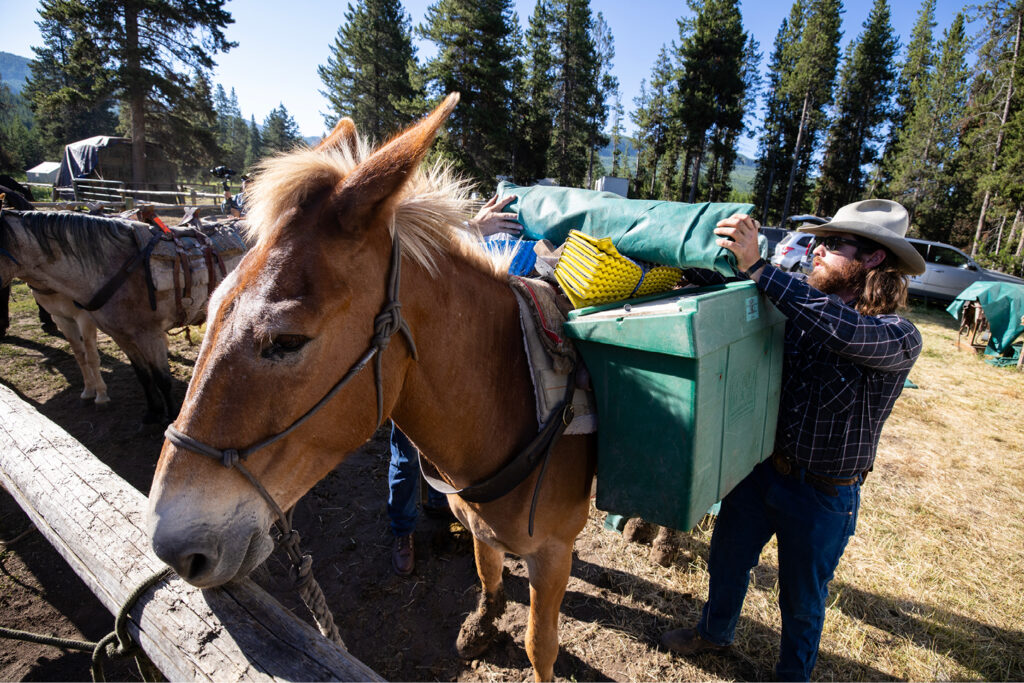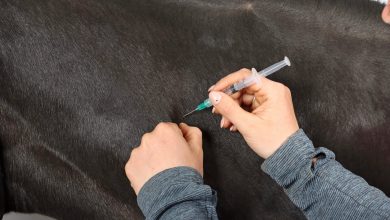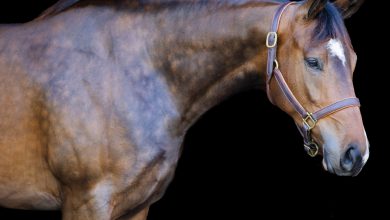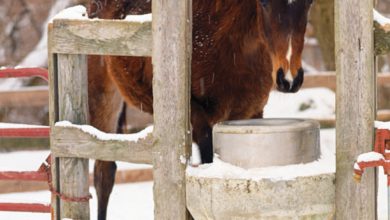
Take your trail riding to the next level with nature-filled adventures in the back or front country.
Planning a pack trip with your horse is a great way for you and your horse to experience nature, disconnect from the hustle and bustle, and learn more about each other. However, it’s not an activity you should embark on lightly, especially if you have little experience. Packing involves multi-day trips into the wilderness where you’re completely reliant on yourself and your horse for everything from your journey to your daily living. Unlike trail riding or even car camping, packing requires some extra finesse and consideration to be done safely.
Here, trail experts Thomas Clover and Allison Parker of Wilderness Trails Outfitters share their decades of experience as horse owners, showmen, outfitters, and wilderness medics to help riders new to horse packing and camping get outdoors. Here, you’ll learn expert tips on getting your horse ready for adventure, packing, and preparing for emergencies.

Whether or not you have a seasoned pack horse, all the preparation for your trip must happen at home first. Packing combines all the risks and potential for accidents of horses with camping or backpacking. Together, the stakes are higher, and the need for preparation increases. If you have a seasoned horse, the work is primarily on you to understand what he’s used to, the gear needed, how to pack, and how to minimize your environmental impact. If your horse is unseasoned, there’s more work to do, but it’s not impossible.
Before setting out, ensure that you and your horse have a base level of skills. First, and foremost, your horse needs to be comfortable on the trail. This means that he can follow other horses or be followed and carry weight. You also want to be sure that he’s comfortable and generally unfazed by obstacles and animals that might appear. If he’s new to the trail, start there.
Get some miles underneath him, preferably with a seasoned horse so he can get comfortable. Next are stock-retention skills. Your horse needs to be ready to handle hobbles, picketing, or electric fences as these are the preferred ways to keep him in place when you’re out. Practice with hobbles or pickets at home to let your horse get used to them. This’ll minimize the likelihood of wrecks in the woods or on the trail where he’s more likely to put himself or you in danger.
[READ: How to Manage Herd Relationships]Now You’re On Your Way!
Once you’ve mastered these basic skills, you’re ready to start trail riding or trailer camping with your horse. This is the next best step to go from day trips to overnight in the backcountry (or away from common camp areas). That’s because it’ll be a new experience to set up your horse’s living area, pack in feed, and then practice good management without the added complexity that comes with being away from the trailer.
Leave No Trace
The idea of “leave no trace” is to minimize the environmental impact of recreational activities. This means cleaning up your space, not unnecessarily damaging the ecosystem, and generally trying to keep a space pristine for others to use and enjoy it.
Stock Retention
Stock retention refers to the practice of containing and keeping your herd together on camping and packing trips. The practices you use in the front country, or while trailer camping, will be slightly different than those you use in the backcountry, or wilderness, with a couple of exceptions. The first exception is the general rule of courtesy. Since trails and camp areas are shared spaces, it’s important to be mindful of the impact you have on the area and other recreationists. The second is to know your herd. As with any group of horses or mules, there will be those that get along better than others, are less destructive, or are calmer. Keep these dynamics in mind in everything you do.
Front country:
Camping near the trailer or a campsite is simpler because there are usually corrals or hitching posts designated for horses. If not, bring portable panels and set up a temporary pen. Before you leave the area, clean up your space. This means picking up or breaking up all manure piles, so it decomposes faster.


Backcountry:
When you’re camping in the wilderness with horses, finding the perfect campsite requires consideration of some additional factors. Unlike backpacking where you might choose a spot because it’s flat and there’s a view, with packing, you need to consider your animals. Typically, you’ll look for a meadow or open space where your animals have enough forage that they don’t wander off.
Make sure there’s enough grass or forage so the horses aren’t eating it to the ground, as overgrazing can make it very difficult for healthy grasses to regrow. You also want an area that has few stumps, willow bushes, and small trees as it’s easy for animals to get hung up on them. Instead, look for larger trees, if there are any at all. Since you’ll have to take the animals to water, you want to be near appropriate drinking water; however, not so close to the water source that they’re tearing up riparian areas or branches. In the backcountry, it’s all about resource management and managing your impact so others—and even you—can enjoy it for years to come.
Free Grazing vs. Tying:
Unlike in the front country where you can pen horses, free grazing is your best option in the wilderness. This is why pre-packing preparation is crucial. You don’t want the wilderness to be the first time your animal experiences hobbles or pickets to practice free grazing. Picketing can be done in a variety of ways, either by putting a stake in the ground on a rope or attached to a tree. You can purchase a picket pin or use a piece of wood with a rope attached to it. Ensure your rope is long enough (at least 20 feet), so your horse can eat and not over-tread or overgraze the area.
When attaching a picket to a tree, find a solid, hardy tree, not a green tree that is likely to get damaged or uprooted. While it’s common to put up a high line to tie off on, it’s not ideal because it causes a lot of damage to the ground. Once you’ve set up camp, check your animals often, including the picket to make sure they aren’t hung up. Before bed, move the picket to prevent overgrazing.
Setting Up Camp
Front country: Again, front-country campsites typically have designated areas for you to camp. Even if it doesn’t, it’s best to keep your core campsite, including food and sleep areas, away from horses. This reduces the smell and number of flies in your space.
Backcountry: When choosing a camping spot, prioritize your animals’ needs over your own. You want to ensure you’re within hearing distance of the area where they’ll be grazing. Again, you’ll want to be far enough away to avoid flies and the smell while reducing the chance of your animals wandering into camp.
First-Aid Kit Essentials
Many of the items you’d take to safely trailer travel with your horse are the items you’ll want in the wilderness, albeit smaller. While it’s important to have first-aid supplies, it’s equally important that you can use it. Practice skills or work with your vet before you head out.
- Surgical scrub and scrub brush
- Brown gauze and Kling gauze
- Forceps
- Xenodine or Betadine liquid solution
- Flushing syringe
- Wound dressing or triple antibiotic ointment
- Rolled or quilted padding
- Vetwrap
- Elastic and adhesive tape
- Scissors
- Hoof pick
- Small hammer
- Shoe and nails or barefoot boot
- Aloeseptic ointment
- Fly repellant
- Bute
- Banamine
- Eyewash and ointment
Gear for the Trail
For animals:
As with everything, you get what you pay for. Your riding or pack animal can get sore easily, so it’s worth investing in quality gear. Find used wood-frame pack saddles, bags, and more online through exchanges and marketplaces or at your local tack dealer.
Other essentials include a ditty bag for miscellaneous items, panniers, hobbles, picket pins, rope, extra horseshoes and/or barefoot boots, piggin strings to attach your animals during travel, an electronic GPS and map to help you navigate the trail, duct tape, and a horse and human first-aid kit. These items will ensure that you can pack everything in and out and that you can safely handle most emergencies that come your way. It’s not uncommon for horses or riders to experience minor flesh wounds or scrapes, lose a shoe, or break something. Most of these challenges can be fixed with a first-aid kit, foot protection, and duct tape.
For riders:
Packing for yourself can be a little trickier if you don’t have backpacking experience. Since weight is a concern, be mindful of what’s need-to-have versus nice-to-have. No one expects you to be at the peak of hygiene so don’t worry about re-wearing clothes. A couple of pairs of pants and shirts will be enough for a short trip.


It’s always best to have at least one spare in case you get wet. For longer trips, like over a week, you may want an extra set of clothes. Bring enough socks and undergarments for comfort and hygiene. Extra socks will ensure that your feet are comfortable the entire trip. Bring a pair of riding boots and muck or rubber boots to wear around camp or in the water. Some people also bring sandals or camp shoes, but that depends on weight and preference. All toiletries should be small, portable versions.
In the front country, you can be a little more liberal with your packing as you’ll be able to store your items in the trunk or trailer rather than transport them.
Read Up Before Saddling Up
The rules and expectations will be different for each wilderness area because the ecosystem is different. As you plan and before you set out, contact the local administration office for that land area. They can help you learn about the rules and what you need to do so you can manage your trip. Government and private agencies can be especially useful as you start because they can point you to information and resources.
Managing the Load
It’s best to have at least one pack animal and one riding animal. Packing and extended trail rides (for the riding horse) are more intense for your animals. Your horse is going up and down hills, managing obstacles, and crossing water and other landscape features. This is more intense than a ride at home in the arena. Plus, unlike with front-country camping, your food, cookware, tent and sleep gear, and horse gear must all be carried in and out. If you’re already a heavier person or have a smaller, less hardy horse, it’s unlikely that your horse can safely carry everything. The hardiness and experience of your pack animal will determine how much to pack but aim to stay within 70 to 150 pounds per animal, excluding the saddle.


Distribute Evenly
When it comes to packing, you want your gear to be tied down as tightly and quietly as possible. Large, floppy, and loose items shift during travel, and even if they’re not heavy, can cause your horse to sore easily as he’ll be working to stay balanced the entire ride. So instead of using giant bags, split your load into smaller, more manageable bags that can fit into a larger pannier (the heavy-duty material sacks you affix to the pack saddle).
Weigh your bags before you go to ensure that your weight will be evenly distributed on your animal, and then pack it down so it’s relatively even in terms of shape. Keep noise to a minimum by leaving the electric toothbrush at home, and securing pots and pans. Not only does the noise take away from your outdoor enjoyment, but it can also spook your or someone else’s animal.
If you don’t have enough animals to do the job, find a buddy or join a group and partner up until you and your horse become more seasoned, and you can build out your pack herd. You don’t need a whole group of horses, but if you’re committed, you’ll want at least one pack animal per one or two riding animals. Plus, adventures are always better with friends.



